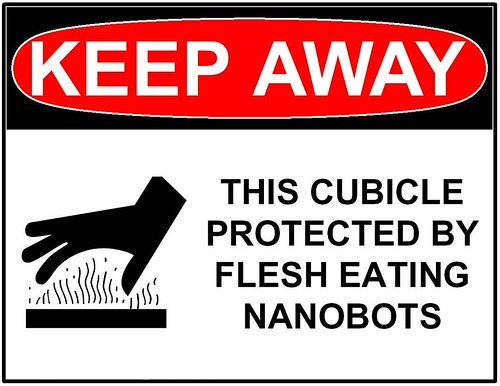A couple of weeks ago, I decided to give up my nanotech writing career – such that it was – and let myself fall back into my old safe and familiar newspaper world. It wasn't so much me giving up on nanotech, but I had thought nanotech had given up on me. Writing about this technology – no, more than that – completely immersing myself in learning about it was the most exhilarating experience of my otherwise average journalism career.
But it had been long past time to come back to earth and start earning a decent living for my wife and three kids (after Sept. 19, four kids!).
So, I was about to formally accept an offer to become the new business editor at the Lansing State Journal – a paper I used to deliver as a boy – and pick up my career arch about where I left it when I bailed out a few years ago to specialize in nanotech. It's a fine paper, a perfectly acceptable job and one that could have sent me up the Gannett ladder if I did a good job and managed not to rub too many people the wrong way.
I don't know if this is a corollary to Murphy's Law, the Peter Principle or "a watched pot never boils," but as soon as I had turned my back on nanotech, those mischievous little buggers decided to swarm around me and drag my wimpy ass back into their world.
OK, yeah, I'm getting way too metaphorical here for a man in my new position. In fact, I should probably drop the nanobot references for now and start thinking of more references to, say, the leading edge of an arrow. How about this: The tip of an arrowhead pierced my back on my way to Lansing, knocking me off that respectable career path once again and back into the exhilarating world of nanotechnology.
I'm the new communications director for Arrowhead Research Corp.
I'll write more about the job and the company later, but I do need to be more careful about what I say. Arrowhead is a public company and this blog, while not affiliated with Arrowhead, is written by its PR person. So, obviously, I need to talk to my new employers a little more. If anybody out there has any thoughts or experience with blogger/public company relations, please let me know. I'd love both of my roles to exist in peace and harmony, of course.
There are downsides to leaping over that wall and going into what journalism purists would call "the dark side," public relations. To some, I automatically lose credibility. But it also helps that I know the journalism profession inside and out, and know how to help reporters tell a story.
But, yes, some opportunities are closed to me now. I can no longer freelance for Wired News, for example. Understandably, they don't want a nanotech PR person writing news stories about nanotech. However, I can probably help nanotech even more by helping publications like Wired News with background material and sources, so they can cover what we do more accurately.
Those who know my work also know that I'm not a slick salesman who would write what he does not firmly believe. My new employers at Arrowhead know about my reputation for fierce independence and hired me either despite or because of it.
For me, I'm incredibly excited about this opportunity to expand my knowledge of nano and have greater access to scientists (especially at CalTech and Stanford) and business leaders who might have been closed to me as a lone freelancer.
So, that's the news from NanoBot for today. Now, let's get back to discussing nanotechnology.
Backgrounder
Flirtin' with Freelance Disaster
Straight into my nano heart
Innovation knows no regulation





 I don't think I'm quoted or referenced in any major
nanotech publication, but -- wouldn't you know it -- here I am in the
I don't think I'm quoted or referenced in any major
nanotech publication, but -- wouldn't you know it -- here I am in the 
 I fled to Northern Michigan last weekend to escape the
I fled to Northern Michigan last weekend to escape the 











 This week I'm writing about how the cutting-edge science of nanotechnology is now helping advance the equally pioneering new field of stem cell research.
This week I'm writing about how the cutting-edge science of nanotechnology is now helping advance the equally pioneering new field of stem cell research.
